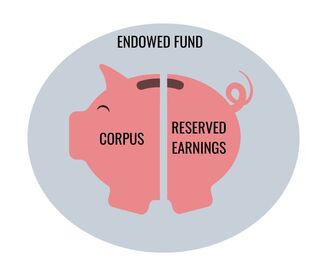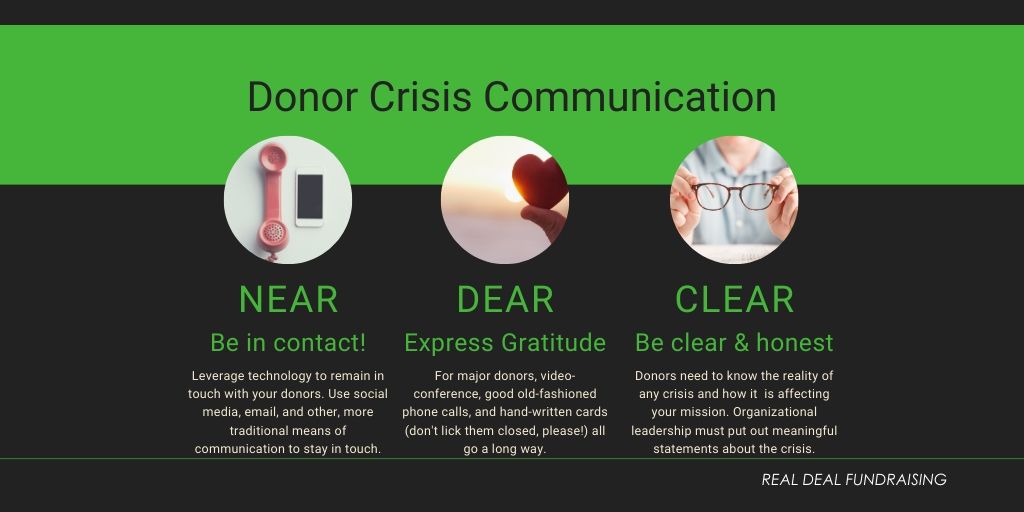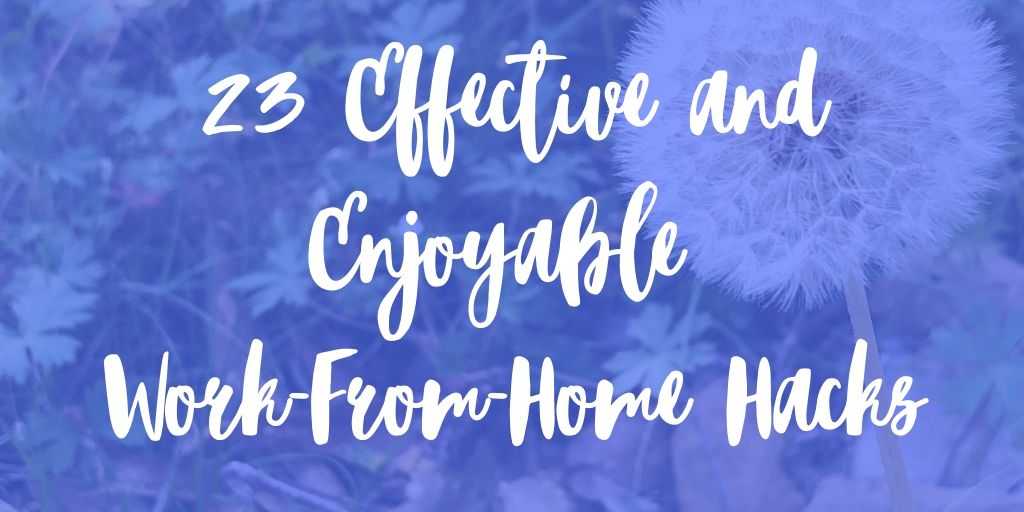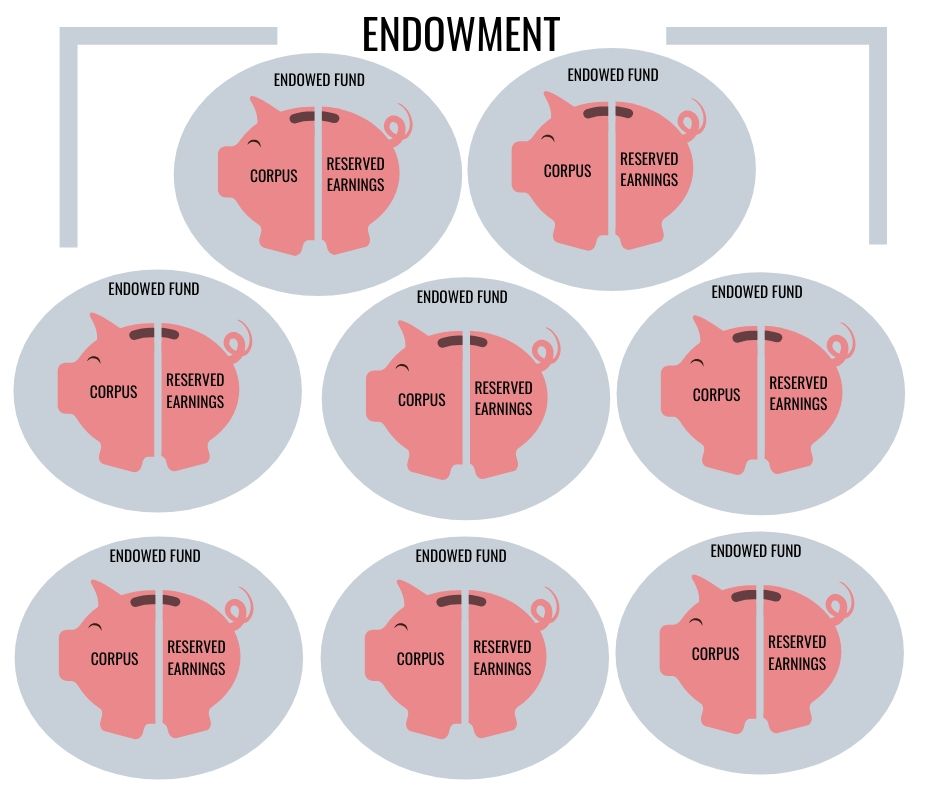We are all scrambling. The situation with COVID-19 changes day-by-day and hour-by-hour. Hopefully by now, nonprofits have taken steps to allow all but absolutely essential personnel to work from home. Fundraising, while essential, is a function that can be done from a home office. The big question is: How can we keep our donors connected to our organizations in this unstable environment? When it became clear that I would not be allowed to travel anymore for work, I fell back on a maxim I heard somewhere early in my fundraising career. It rhymes so that’s convenient and an aid to memory. Near Dear Clear In any circumstances where rapid change is taking place, we must take great pains to keep our donors near, dear, and clear. What does that mean as a guide to practical action and how can we all undertake those functions while protecting ourselves and our donors from coronavirus? Let’s take each part of the maxim in turn: Near: Be in Contact!You will need to leverage all forms of media at various levels to keep in touch with your donors. First, for your major donors, set up as many one-on-one Zoom meetings as you can reasonably handle each week to check in with them and make sure their families are doing okay right now. Take it week-by-week so it will not be overwhelming but striving for 6-8 substantial phone calls or Zoom meetings with major donors per fundraiser seems appropriate. Secondly, utilize digital means of connection as much as possible. The president of the institution I work for is doing a series of Facebook live discussions this week at the same time every day. Send email updates or text your constituents. Don’t bombard them with info but if you have meaningful information to report, do so on all available channels. If you have Facebook groups, use those to communicate too. Encourage your supporters to share info so it gets in more Newsfeeds and inboxes. Third, for your mid-level donors or major donors that you cannot check in with immediately, don’t forget about good old mail and phone. You can do a quick check-in calling campaign one day per week and write some hand-written notes. (Of course, please be careful with your mail protocols for hygiene. Use self-adhesive stamps and tape if possible. Barring that, seal or affix with a sponge. And wash your hands well before handling mail to be sent out.) Dear: Express GratitudeYour messaging needs to let donors know that you care about them as people. It’s not just about expressing our usual level of stewardship and gratitude. This is thanking them for believing enough in your organization’s mission to hang in there in this time of great change and uncertainty. Express gratitude not only as a staff member but express gratitude on behalf of those your organization serves. Let them know that because of them, your mission continues and will continue after COVID-19. Clear: Have Clarity, Openness, and HonestyMake sure your organization is crystal clear on its priorities. The first of which should be the health, safety, and welfare of those they serve and those who work for the institution. Repeat this often to your constituents.
However, do not shy away from honestly telling donors how this crisis is affecting your organizational needs and its finances. Your major donors and board members especially deserve the candid talk about what is needed, what might be needed, and why. Did you find the framework of near, dear and clear helpful in thinking about how you are keeping donors connected these days? What other strategies have you tried in the last couple of weeks that keep donors near, dear, and clear? Tell me below in the comments! Again, I hope this was helpful to you. If it was, please leave me a comment below. Also, if you found this very helpful, I hope you’ll subscribe. By doing so, you’ll get my FUNdraising Friday emails every Friday with pick-me-ups, helpful articles, and cool freebies. Humor and a commitment to continual learning will no-doubt help us all through this crisis. Take care and be well, Jessica PS - If you are feeling stressed and anxious and burnt out due to coronavirus, you're not alone. Because so many are facing unprecedented challenges and pressure right now, I'm hosting a free webinar on the topic of Self Care for Non-Profit Professionals. It will take place April 1st. Register today as there are only 100 spots! The first time I worked from home was honestly a miserable experience. In a new job that was not front-line fundraising, with a 3-month-old baby and beagle at home, I was also mired in postpartum depression. I realize now that I made a lot of mistakes. When I got another remote position in 2015 (this time in fundraising), I decided I was going do things differently. At that time, I had a 6-month-old and a 5-year-old, and my husband was a stay-at-home dad. We were homeschooling my Kindergartener and would continue that until this past September. Certainly, we made mistakes, but I’ve learned much along the way and I’m now so thoroughly adjusted to working this way that I can’t imagine going to an office everyday (that isn’t just up my stairs). Let me pause to say that I understand how insanely lucky I am, and I do not take that for granted. In this crisis, many must worry about whether they will get a paycheck, whether they will have to go into work and possibly contract the virus, and how they will feed their kids and get Wi-Fi at home so their children can complete their schoolwork. The transition back to having kids at home will be smooth for my family and I’m so grateful to work for a school that has embrace distance learning and remote work for a long time now. I’m able (because of my privileged position) to focus on finding innovate ways to connect with donors in this crisis and providing support for the community of non-profit fundraisers. All of that acknowledged, for those of you who have information technology jobs and relationship-based jobs (like fundraising), I hope to provide some of the insights I’ve learned in the last 5 years to ease your transition into this new style of working. If you find one or more of these tips helpful, please let me know in the comments. GENERALGive everybody grace: Everyone is struggling to adjust right now. People are having to learn new ways of being, as well as new skills. People are filled with worry, anxiety, grief, and many other emotions. Give yourself grace. Give your spouse or partner grace. Give your kids grace. Give your extended family grace. Give your co-workers grace. Give the people your organization serves grace. Time: You will get a lot more done in less time. The big secret of working from home is that you work less but you get more done. (It’s true for your kids too but we will get to that.) Focus on tasks accomplished not on hours put in. Use the extra time for self-care. Exercise: Get some. Get outside, if that is advisable where you are. If not, here’s a great YouTube channel with indoor walking activities that you can do even if you’re in a small space. You probably won’t realize how much incidental movement you got during an average workday before COVID-19. Working from home requires putting in thoughtful effort to move your body. My goals are to get my 10,000 on my FitBit and do at least 15 minutes of yoga daily. Both help my body, my mind and my spirit. Boundaries: Communicate with your family about when you have obligations throughout the day and when you’ll be done. A family calendar is a good start. Stop working after a certain time. Just put it down. Because you are in your home, there is a kind of creeping that can happen where work ends up flowing into time that should be for yourself and your family. Housework: Another benefit of working from home is you can blend your house maintenance in throughout the day. You can throw a load of clothes into the washer before a meeting and then switch it around after the meeting is done. The downside: with your whole family at home all day, the house gets into disarray faster and you’ll need to tidy it up more often. Food: It’s easy to graze all day. Resist the urge. I like to use the Crockpot or the Instant Pot so I know dinner is taken care of and I do simple breakfasts and lunches so I’m not in and out of the kitchen quite as much. Thinking-outside-the-box: As fundraisers, our job is to present the funding needs of our institutions as effectively as possible. We must ALL find new ways to do things now. That may mean a return to “old-fashioned” things like hand-written notes and cards or it may mean holding events virtually that you’ve done in person before. Working from home gives you the space to research, learn, plan and innovate. MOTIVATIONEat the frog: If one of the things you had to do today was eat a frog, when would be the best time to do it? At the end of the day, after you’ve spent your whole day dreading it? No! You eat the frog first thing! Your most taxing or unpleasant task of the day should be your first. Get it over with! Everything will seem downhill after that. Batching: If I’m attempting to set up meetings with donors, I send out all the emails inviting people meet with me on one day during one two-hour period. If I need a day to write a serious report or proposal, I block that day and don’t schedule meetings then. If you must get some thank you cards out, do them all at once. Batching makes you more efficient and you’ll have more time for that all-important self-care. The Pomodoro Method: You can google this and learn more about this method. If you have a big task and it seems too daunting to do all in one go, tell yourself you are going to work on it for 20 minutes and then take a 10-minute break. Maybe you repeat the cycle immediately after the break or later than afternoon or the next day. But setting a time limit helps you get started. If you feel like you’re in the zone at the end of the period keep going if you want. For the record, this works with personal stuff too. I use it for cleaning. I set a timer for just 15 minutes and then I can stop when the buzzer goes off - no matter how far along I am. Sometimes I stop, but often I’m making such great progress after 15 minutes that I just want to get it all the way done. It’s a win either way! Three Things: If there is just too much to get done, writing a to-do list will make you more overwhelmed but a three things list forces you to prioritize deeply and then you work until those things are done. (I wrote an entire blog post about the Power of a Just Three Things list.) Routine or Flow (not a schedule): I don’t have a schedule as such. Obviously, I have some standing meetings, but I can’t let myself get too attached to schedules. I have a natural inclination towards the Hermione Granger end of things (super type A) and if left to my own devices I would make myself into a neurotic mess trying to stick to a schedule. So, instead of that I focus on flow and routine. I follow how I’m feeling and what I feel I can best work on at any given time. I also have things for my own self-care that try to check off daily, though I am unattached to when or how they get done (exercise, yoga, cleaning, etc.) PHYSICAL SPACE AND GEARDesignate an office space: It doesn’t have to be a “room-of-one’s-own” but a small desk or one end of dining room table. Some place you can “set-up-shop” and feel comfortable and keep yourself semi-organized. Decorate it (or at least have a good view): Rearrange the furniture to look out a window. Put a vase of flowers from your yard near your monitor. Move some of your art around so you can see it from your new home office. Bring beauty into your workday somehow. Comfort: Find a good chair or put some cushions in whatever chair you’ve got. I like to put a large exercise ball under my desk to prop my feet on during conference calls. Get comfortable. It’s worth it. Watch your posture: It’s so easy to slump at home because (unless we are on video-conference) we are relaxed and not trying to impress anybody. That’s good, but remind yourself to sit up straight sometimes and do some simple stretches during the day (because you can, you’re at home!). I love Adriene from the Yoga with Adriene YouTube Channel and not only does she have playlists including: Yoga for Uncertain Times, Yoga for Neck Tension and Yoga Practices Under 10 Minutes long. Get a Lift: If you are working with a laptop, I highly recommend a docking station with a regular monitor. Realizing that you probably cannot access tech gadgets right now, get a big book, like a dictionary and prop up your laptop when you are on conference calls for sure (all the time, if you have a separate keyboard available to you). This will prevent you having to look down into the screen and therefore save your neck from soreness. (It will also make you look a bit better on video-conferences because the camera will be level with your face or higher than your face. ZOOM (AND OTHER VIDEO-CONFERENCING SOFTWARE)Have a sense of humor: If your kids interrupt your Zoom calls, you can just ask them to say hi (if appropriate) or just mute and shuffle them out. Then make a joke about it: “Well at least he had pants on!” No need to freak out or punish them. Just gently set boundaries. Your co-workers should be giving you and everyone grace right now. Same thing applies for pets. People love seeing your kids and your pets. Don’t worry about seeming professional right now. Wear pants, please: Yes, you must wear pants on video-conference! Inevitably, you’ll have to get up to adjust your lighting, run to the restroom, handle something a child needs, grab a paper, or close a window. So, yes, wear some pants. That said, they can be comfy yoga pants or pajama pants. No one will fault you for that. Touch Up Appearance Function: If the idea of looking at your own face in a little box on Zoom all day activates your perfectionist and self-critical tendencies (maybe it’s just me), you can use Zoom’s feature call “Touch Up Appearance”. Basically, it just removes any major blemishes and improves dark circles under my eyes. I still look thoroughly like me. Use your mute button: If you are not talking or expected to talk very soon, for the love of all that is dear in this beautiful world, mute yourself. It’s the microphone button in the bottom left corner. If you are dialing in via phone and not video, please mute too using your phone’s features. Zoom can be the best of tools and the worst, improperly used. Mute yourself when aren’t talking. Use your video on/off button if necessary: If you must leave a meeting a quick note in the chat “brb” for “be right back” and then turn your video off momentarily. It’s the button in the bottom left corner with the camera icon. Turn it back on when you return. Be careful about chat: Zoom’s chat feature is a bit weird. You can message specific people directly, but then it doesn’t automatically switch back to all. Be careful with this and make sure you get the right not to the right audience. Otherwise, embarrassing situations could arise. SCHOOLING FROM HOMEOk, I’ve got one final category of tips for those parents out there who are navigating the un-charted waters of having their kids home all day for the whole workweek. You're probably thinking "How do I get them to do their work? How can I get all my work done too?"
First, let’s be clear: this is a highly unusual situation for everyone. Remember how we need to give everyone grace. That includes kids. They absorb all the unspoken worry and fear around them, and it can cause them to act…. less than pleasant and cooperative. Be kind and give them some leeway. That said, I would not let extreme cases of defiance and disrespect slide. Otherwise, you are setting some precedence that will cause you trouble later, especially if this situation persists for months and not weeks. Sound like contradictory advice? I’ll cop to that. That’s what parenting is: finding a balance amidst the many paradoxes of raising little humans. On to the specific tips:
Again, I hope this was helpful you. If it was, please leave me a comment below. If you found this very helpful, I hope you’ll subscribe. By doing so, you’ll get my FUNdraising Friday emails every Friday with pick-me-ups, helpful articles and cool freebies. At the end of this, I’d like to say again that I know how lucky I am to have the kind of job I have that allows me to work from home, especially at a time like this. So many don’t have this opportunity. Cultivating gratitude will help us all build resilience for this challenge. Take care and be well, Jessica FREE FUNDRAISING IN A CRISIS WEBINAR REPLAY
CRISIS COMMUNICATION
INCLUDING CRISIS IN YOUR STRATEGIC PLANNING
GENERAL COVID-19 RESOURCES
FUNDRAISING EXAMPLES
PICK-ME-UPSFUNDRAISING RESOURCES
FUNDRAISING ANALYSIS
COMPANIES DOING THE RIGHT THING RIGHT NOW
If there are other great resources for working through this crisis that you've found helpful, please comment below and let me know about them. If you found this post helpful, please comment and let me know that too! Also subscribe to Real Deal Fundraising so you don't miss the next post! You’ll also start to receive my FUNdraising Friday emails where I bring you curated information and super cool freebies exclusively for my subscribers! And don't forget to visit my store for transformative training and consulting products!
 If you weren’t a finance major (I wasn’t), learning the ins and outs of endowments can be intimidating. But fear not! Endowments are easy to understand once you know some basic terminology. Becoming proficient with these terms is essential if you want to grow a career in fundraising. Being able to converse intelligently about endowment issues is a must for nearly all development professionals. Luckily, I worked with three phenomenal CPAs at my last job and I owe those ladies a lot, because through their patience I learned this essential information well enough to utilize it in my fundraising and to teach it to you here! I find that it’s helpful to explain things in terms of a household budget so I’ll give the standard explanations and then I’ll give my liberal arts definition. What is an endowment anyway? First off, the main idea of an endowment is like a savings account where you never ever touch the original amount you put into the fund. Imagine you won the lottery and took the lump sum option and after buying a house and some cars and taking a big vacation, you put the remaining money into a savings account. You decide not to touch it and live off some of the investment earnings. That’s all an endowment is! The original amount that you put into the account goes by several names in the nonprofit world: corpus, principal, or the permanently restricted part of the endowment. I tend to use corpus most often. Surely it’s not that simple? You’re right! It’s not. As we all know earnings in the investment world are neither guaranteed nor constant. Thus, if you want to maintain your originally invested amount in perpetuity (that’s accountant-speak for forever), you’ll need to be careful with how much you spend year to year. Let’s say that the market averages 8%. You would not want to spend all 8% of your earnings that year, because next year you could earn only 3% or *gasp* have a negative return. This is why most nonprofits put a cap on the amount of the earnings that can be spent, often only 4 or 5%. That’s called the spending allocation. (This could be for scholarships or program support, anything that the donor and the organization wishes to fund. What the spending allocation gets used for is governed by a written agreement between the organization and the donor. I call it a fund agreement but other groups use different names for the same document.) Anyhow, the spending allocation is the portion of the annual investment earnings authorized to be spent on the mission of the endowed fund. (One endowment can have many endowed fund under its umbrella. Think different scholarships or faculty support funds in a higher education context.) In the metaphor of you winning the lottery and putting a large lump sum in an investment account to live off of, you might earn 8% but you’ll only spend 5%. So if your lump sum was $10,000,000, you’ll need to find a way to live off of $500,000 annually rather than $800,000. What happens to the earnings not spent? There are generally 3 things that can happen to earnings not spent.
Each organization will have an investment policy for its endowment and a target investment earnings that they hope to reach. You can see why: if you need 5% for the spending allocation, 2% for the administrative fee(s), and some to hold in reserved earnings for a rainy day (or a bear market year), suddenly your endowment needs to clear 8-10% every year for everything to remain viable and run smoothly. Now here’s a mind bender for you: if a fund earns some returns but not all the way to your target and the total market value is over the corpus amount, you can’t give it a full spending allocation. That’s called underfunded. (Not to be confused with underwater, but seriously how could you not confuse them. This took me YEARS to figure out completely.) Here’s the analogy: Your $10 million is still intact and you’ve banked another $100,000 in reserved earnings, you earn only earn 3%. Remember your usual allocation is $500,000. So, you made $300,000 and you have $100,000 extra without touching your original investment, but that’s only $400,000. Guess you better stock up on ramen until next year! And furthermore, it’s likely that as a good manager you wouldn’t want to wipe out your entire reserved earnings lest the situation of lower than expected earnings continue for another year. So, you might only allocate $200,000 be spent this year, leaving $200,000 in reserved earnings. That’s an underfunded endowment. Whew! Now my brain hurts. Let’s talk about something else. I hear about divestment. What’s that? Many organizations with long standing endowments managed their investment only for strong returns and with little regard to the greater social good. This means some prominent endowments are invested in things such as fossil fuel companies or private prisons or other things that are actually at odds with the organization's mission in some cases. For instance, if you were an animal lover, and you hear from your financial planner that a significant portion of your $10 million nest egg was invested in cosmetic companies that cruelly test on animals but you’ve been making phenomenal returns. What would you do? If you told them to move to other companies that are cruelty free but to do it in a way that hopefully preserved returns, that’s divesting from companies profiting from animal cruelty. Conscious Investment Some organizations are so committed to their mission and values that they do not want their endowments to be utilized in ways that are contrary to their values as an organization. These groups can decide to invest in what are sometimes called ESG or environmental, social and good governance funds, ensuring that organizational monies are not used to exploit people’s labor, trample their rights, damage the environment, or other things that are negative. In some cases, ESG funds can be invested in companies that are not doing things the right way as part of a strategy of putting pressure on the companies as investors. This has been done successfully to influence labor disputes and to support the growth of clean technology divisions at fossil fuels companies, for example. Constituents including donors, program recipients, the general public, students (in the education field) can lobby and put pressure on governing boards of non profits to divest from certain areas which they feel are in conflict with the values of the organization. Leadership can also chose to divest as part of a vision for the future of the organization. How can I use this information as a fundraiser? I’m going to cover that in an upcoming post “Fundraising and Endowments”. Stay tuned by subscribing. You’ll receive my FUNdraising Friday emails where I bring you curated information and super cool freebies exclusively for my subscribers. Do you find endowment-talk intimidating? Did this post help to demystify it somewhat? What questions do you have for me to answer in my upcoming "Fundraising and Endowments" post? Comment below and let me know! Comments and questions are, as always, welcomed and encouraged! Cheers, Jessica Cloud PS – If you liked this post, you might also like these:
PPS - If you found this article helpful, please comment and let me know. Also subscribe to Real Deal Fundraising so you don't miss a post! You’ll start to receive my FUNdraising Friday emails where I bring you curated information and super cool freebies exclusively for my subscribers! And don't forget to visit my store for transformative training and consulting products! |
Jessica Cloud, CFREI've been called the Tasmanian Devil of fundraising and I'm here to talk shop with you. Archives
June 2024
Categories
All
|





 RSS Feed
RSS Feed
